Coastal colour, planting by the sea
Luckily, the choice of plants that are happy in coastal regions is surprisingly wide and varied. Apart from our many native plants which have evolved to cope with life on the coast, we also have hundreds of Australian, South African and Mediterranean plants born to thrive at the seaside.
So what makes a good coastal plant? Growth habit is a clue. When there’s a cold wind blowing it makes sense to lie low. Low mounding forms and ground hugging carpets also fit the bill when there’s a precious view to preserve.
Wind and drought tolerant plants tend to have a certain look about them. Hard, thick or waxy leaves, and small or narrow needle-like leaves are features that protect against moisture loss in drying winds.
Silver or grey foliage is a strong indicator that a plant will thrive in hot dry conditions. New Zealand native astelias offer sculptural form and glistening silvery foliage. Astelia ‘Silver Spear’ and the finer leafed A. banksii will grow right up to the base of the sand dunes. They’ll cope with harsh wind and frost, but dislike wet soil. Handsome Marlborough rock daisy (Pachystegia) also thrives under such conditions, with white daisy flowers rising above thick leathery leaves, growing wild on steep cliffs where their roots that reach deep into rock fissures.
With spikes foliage and bright red comb flowers, Poor Knights lily (Xeronema) grows on exposed rocky outcrops where there is full sun, limited root space, scarce nutrition, extreme drainage and no frost.
Not all coastal soils are sandy. Many seaside properties combine heavier clay soils with salt laden wind. Such soils can be advantage, holding onto moisture to support a wider range of plants, including roses. Tough rugosa and Flower Carpet roses are great for coastal gardens.
Clay banks need plants that bind the soil and prevent erosion. Native pōhutukawa, kōwhai and kānuka are natural contenders for coastal cliffs, along with kawakawa, hebes, flax, and many others. Native plants grown from seed collected locally are perfect.
Flax, cabbage trees and tussock grasses bring movement and exciting textural contrast to coastal gardens. The huge variety of different flax varieties provide for a colourful garden, with or without flowers. Australian rush grasses (Lomandra) are extremely drought and heat tolerant, fantastic for mass planting or in pots.
Rengarenga lilies (Arthropodium) grow wild on the sheer rock faces of the New Zealand coastline, their white flowers a picture in late spring. This useful low maintenance plant is great for mass planting in sun or dry shady areas under trees. Variety ‘Matapouri Bay’ is one of a few superior selections with thick foliage that's less prone to snail damage.
Many plants from distant shores can be seen thriving in New Zealand’s seaside gardens. From the Mediterranean we have silvery olives, lavender, rosemary and rock roses (Cistus). Colourful geraniums (Pelargonium), border pinks (Dianthus) and sea thrift (Armeria) are great for pots.
Plants from South Africa’s Cape Province are among the best coastal plants, including bright African daisies (Arctotis, Osteospermums and Gazanias), hot pokers (Knifophia) and vibrant Lampranthus (ice plants). Proteas and Leucadendrons are especially colourful in winter.
Tough and colourful Australian plants for coastal gardens include Grevilleas and Callistemon (Bottlebrush). The Banksias make excellent shelter trees and their flowers are a valued source of winter nectar for birds.
While all succulents cope with drought, many will also tolerate salty air. Larger desert dwellers such as Agave, Aloe, Yucca and Optunia (prickly pears) thrive in coastal gardens. Aeonium and Sedum varieties also love a hot seaside location.
If a coastal garden is well protected with thick shelter planting, an even wider range of plants can be grown. Unsurprisingly, some of the best shelter trees for NZ coastal conditions are our natives; Pohutukawa, Karo (Pittosporum crassifolium), Olearia, Corokia and Griselinia.
Gardening by the sea
- Grow trees and tall shrubs to create shelter for you and your plants.
- Mix compost and controlled-release fertiliser with the soil at planting time.
- Use rocks to anchor and shelter plants and to protect their roots.
- Mulch to retain moisture. Seaweed makes good mulch.
50 of the best plants for coastal gardens
Trees, shrubs and hedges
Astelia, Brachyglottis, Callistemon (bottlebrush), Cistus (Rock rose), Corokia, Griselinia, Karo (Pittosporum crassifolium), Lavender, Leucadendron, Leucospermum, Metrosideros (Pohutukawa), NZ flax (Phormium), Olive, Olearia, Pachystegia (Marlborough rock daisy), Protea, Rosemary, Westringia.
Climbers
Bougainvillea, Roses, NZ Clematis.
Perennials and groundcovers
Arctosis, Cerastium tomentosum, Coprosma acerosa, Dichondra ‘Silver Falls’, Echeveria, Echium, Gazania, Meuhlenbeckia, Osteospermum, Rengarenga lilies (Arthropodium), Rosemary, Stachys lanata (lambs ear).
Grasses
Carex, Chionochloa, Festuca, Lomandra.
Accent plants
Echium, Marlborough rock daisy (Pachystegia insignis), Poor Knights lily (Xeronema), Agave, Aloe, Yucca.
Colour in pots
Alstroemeria (dwarf forms), Armeria, Gazania, Pelargonium, Dianthus, Lampranthus, Lavender, succulents.

1-Dec-2021
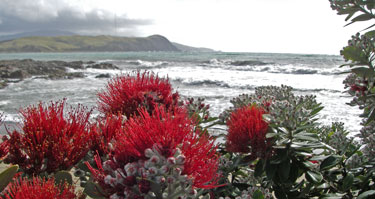
NZ's own pohutukawa (Metrosideros) thrives on a coastal shore

A Marlborough rock daisy (Pachystegia) hanging out on a limestone cliff at coastal Kaikoura
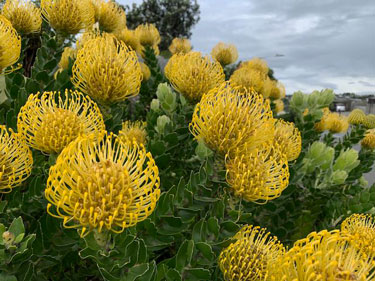
Leucospermums love a sandy soil and ignore the wind. They come in a range of bright yellow, orange and pink tones.
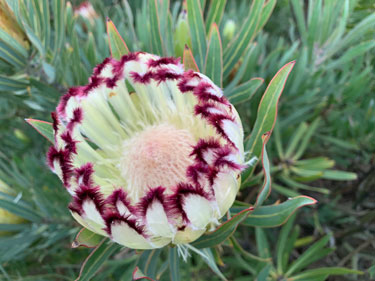
Proteas and their close cousins leucadendrons, have thick silvery leaves that tolerate salt laden winds.
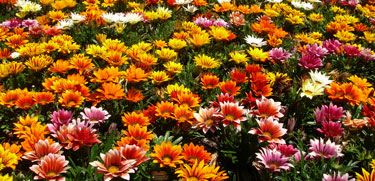
Gazanias provide a carpet of bright sunset colours that thrive in the heat and sun.
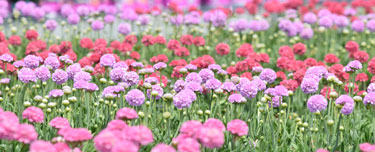
Armerias are tough little perennials that love the sun and thrive in pots

Aloe polyphylla is both tough and beautiful
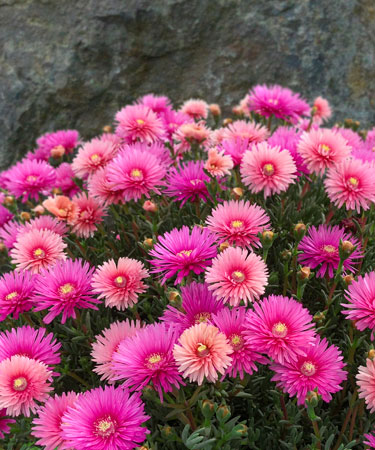
Lampranthus is a colourful carpeting succulent

